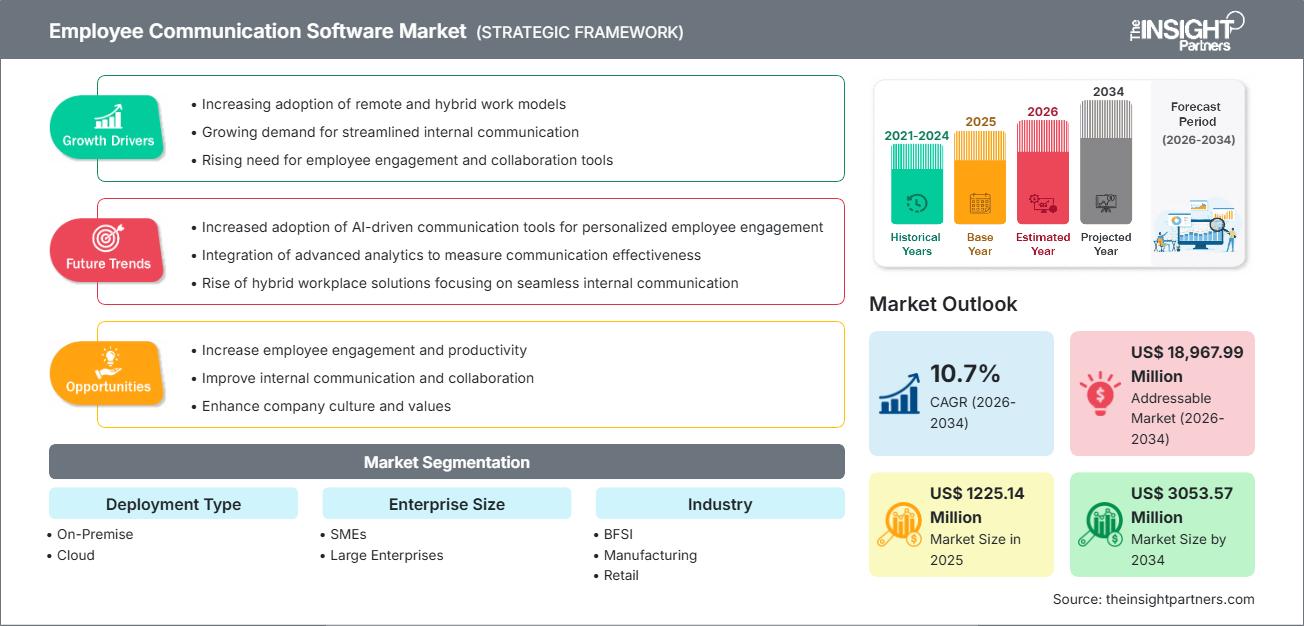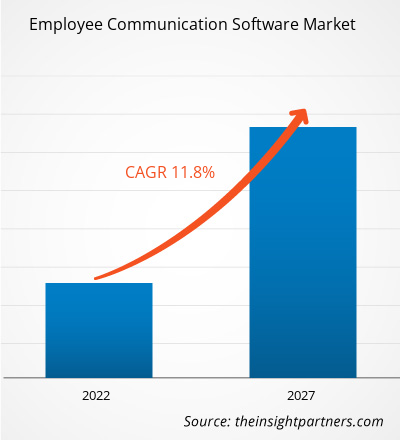Si prevede che il mercato dei software di comunicazione per i dipendenti crescerà da 1.225,14 milioni di dollari nel 2025 a 3.053,57 milioni di dollari nel 2034. Si prevede che il mercato registrerà un CAGR del 10,7% nel periodo di previsione 2026-2034.
Analisi di mercato del software di comunicazione per i dipendenti
Il rapido passaggio a modelli di lavoro da remoto e ibridi stimola la crescita del mercato dei software per la comunicazione aziendale, poiché ha aumentato la necessità di soluzioni potenti per la comunicazione interna. Gli investimenti nella trasformazione digitale del posto di lavoro per migliorare il coinvolgimento dei dipendenti, la collaborazione e il feedback in tempo reale favoriranno l'adozione di soluzioni integrate di intelligenza artificiale, automazione e analisi avanzate per la personalizzazione delle comunicazioni e la misurazione dell'efficacia.
Panoramica del mercato dei software di comunicazione per i dipendenti
Applica dati e analisi per misurare l'efficacia della comunicazione e ottimizzare il coinvolgimento interno. Le soluzioni supportano messaggistica, annunci, feedback, sondaggi e collaborazione in tempo reale. ECS aiuta quindi le aziende di ogni dimensione, dalle piccole e medie imprese alle grandi imprese, a semplificare efficacemente la comunicazione, migliorare il coinvolgimento e mantenere l'allineamento tra i team distribuiti.
Personalizza questo report in base alle tue esigenze
Riceverai la personalizzazione gratuita di qualsiasi report, incluse parti di questo report, analisi a livello nazionale, pacchetto dati Excel e potrai usufruire di fantastiche offerte e sconti per start-up e università.
Mercato dei software di comunicazione per i dipendenti: approfondimenti strategici

-
Scopri le principali tendenze di mercato di questo rapporto.Questo campione GRATUITO includerà analisi dei dati, che spaziano dalle tendenze di mercato alle stime e alle previsioni.
Driver e opportunità del mercato dei software di comunicazione per i dipendenti
Fattori trainanti del mercato:
- La crescente adozione del lavoro da remoto e ibrido richiede una comunicazione interna fluida.
- Crescente domanda di strumenti per il coinvolgimento e la collaborazione dei dipendenti.
- Crescente adozione di piattaforme di comunicazione basate su cloud per supportare in modo flessibile e scalabile una forza lavoro distribuita.
- Integrazione di intelligenza artificiale, automazione e analisi avanzata per personalizzare la comunicazione e misurarne l'efficacia.
Opportunità:
- Sfrutta dati e analisi per misurare l'efficacia della comunicazione e ottimizzare il coinvolgimento interno.
- Utilizzare strumenti basati sull'intelligenza artificiale (chatbot, notifiche intelligenti) per automatizzare la messaggistica interna di routine.
- Sviluppare piattaforme mobile-first per i lavoratori senza scrivania o sul campo che si affidano agli smartphone per comunicare.
- Espandi la tua presenza nelle aziende globali offrendo supporto multilingue, comunicazioni sicure in tempo reale e canali di feedback.
Segmentazione del mercato del software di comunicazione per i dipendenti
Per tipo di distribuzione:
- In sede
- Nuvola
Per dimensione aziendale:
- PMI (Piccole e Medie Imprese)
- Grandi imprese
Per settore:
- BFSI
- Produzione
- Vedere al dettaglio
- Assistenza sanitaria
- IT e telecomunicazioni
- Altri settori
Per geografia:
- America del Nord
- Europa
- Asia Pacifico
- America meridionale e centrale
- Medio Oriente e Africa
Approfondimenti regionali sul mercato dei software di comunicazione per i dipendenti
Le tendenze e i fattori regionali che hanno influenzato il mercato dei software per la comunicazione con i dipendenti durante il periodo di previsione sono stati ampiamente spiegati dagli analisti di The Insight Partners. Questa sezione illustra anche i segmenti e la distribuzione geografica del mercato dei software per la comunicazione con i dipendenti in Nord America, Europa, Asia-Pacifico, Medio Oriente e Africa, America Meridionale e Centrale.
Ambito del rapporto di mercato sui software di comunicazione per i dipendenti
| Attributo del report | Dettagli |
|---|---|
| Dimensioni del mercato nel 2025 | 1225,14 milioni di dollari USA |
| Dimensioni del mercato entro il 2034 | 3053,57 milioni di dollari USA |
| CAGR globale (2026 - 2034) | 10,7% |
| Dati storici | 2021-2024 |
| Periodo di previsione | 2026-2034 |
| Segmenti coperti |
Per tipo di distribuzione
|
| Regioni e paesi coperti |
America del Nord
|
| Leader di mercato e profili aziendali chiave |
|
Densità degli operatori del mercato dei software di comunicazione per i dipendenti: comprendere il suo impatto sulle dinamiche aziendali
Il mercato dei software per la comunicazione con i dipendenti è in rapida crescita, trainato dalla crescente domanda degli utenti finali, dovuta a fattori quali l'evoluzione delle preferenze dei consumatori, i progressi tecnologici e una maggiore consapevolezza dei vantaggi del prodotto. Con l'aumento della domanda, le aziende stanno ampliando la propria offerta, innovando per soddisfare le esigenze dei consumatori e sfruttando le tendenze emergenti, alimentando ulteriormente la crescita del mercato.

- Ottieni una panoramica dei principali attori del mercato dei software di comunicazione per i dipendenti
Analisi della quota di mercato del software di comunicazione per i dipendenti per area geografica
- Nord America: storicamente dominante, trainato dall'adozione precoce di luoghi di lavoro digitali, da una solida infrastruttura tecnologica e da grandi aziende.
- Europa: domanda in aumento a causa della conformità normativa, della trasformazione digitale e dell'attenzione all'esperienza dei dipendenti.
- Asia-Pacifico: questa regione ha un potenziale elevato grazie all'aumento del lavoro da remoto, alla crescita delle PMI e all'adozione sempre più diffusa del cloud.
- America meridionale e centrale, Medio Oriente e Africa: adozione emergente, soprattutto tra le aziende che investono nella trasformazione digitale e nelle piattaforme di comunicazione interna.
Densità degli operatori del mercato dei software di comunicazione per i dipendenti: comprendere il suo impatto sulle dinamiche aziendali
Il mercato ECS è caratterizzato da un mix di fornitori di piattaforme di comunicazione specializzate, aziende di software aziendale e fornitori di strumenti per le risorse umane. La concorrenza si sta intensificando a causa di:
- Richiesta di un'integrazione fluida con i sistemi HR, gli strumenti di collaborazione e le piattaforme di feedback.
- Differenziazione tramite coinvolgimento basato sull'intelligenza artificiale, analisi e funzionalità di notifica intelligenti.
- Scalabilità e flessibilità attraverso architetture cloud-first.
- Sicurezza e crittografia per garantire che le comunicazioni interne siano sicure e conformi.
Le principali aziende che operano nel mercato dei software per la comunicazione con i dipendenti includono:
- Apicoltore AG
- Nudge Corporation
- Poppolo
- Simpplr Inc.
- Smarp Oy
- SnapComms Inc.
- Sociabble, Inc.
- Staffbase
- l'app EMPLOYEE
Altre aziende analizzate nel corso della ricerca:
- Soluzioni StaffHub
- Connecteam Inc.
- Workvivo
- Happeo
- BlinkApp
- Zoho Connect
- Jive Software (una società Aurea)
- Foko Retail
- Oktopost
Notizie e sviluppi recenti sul mercato dei software di comunicazione per i dipendenti
- Crescente integrazione di funzionalità basate sull'intelligenza artificiale (notifiche intelligenti, chatbot) nelle piattaforme di comunicazione dei dipendenti per migliorare il coinvolgimento e ridurre le spese generali manuali.
- Crescente passaggio a implementazioni basate su cloud, man mano che le aziende ampliano la propria infrastruttura di lavoro remota e ibrida.
- L'adozione di piattaforme di comunicazione mobile-first, in particolare per i lavoratori in prima linea o senza scrivania, consente l'interazione in tempo reale in movimento.
Copertura e risultati del rapporto di mercato sui software di comunicazione per i dipendenti
Il rapporto "Employee Communication Software Market Forecast to 2027" di The Insight Partners fornisce:
- Dimensioni e previsioni del mercato a livello globale, regionale e nazionale per tutti i segmenti chiave.
- Tendenze dettagliate, fattori trainanti, vincoli e opportunità di crescita.
- Analisi PEST e SWOT del mercato.
- Panorama competitivo, tra cui concentrazione del mercato, analisi della mappa termica e fornitori chiave.
- Profili aziendali dei principali attori del mercato ECS.
- Analisi storica (2 anni), anno base, previsione (7 anni) con CAGR
- Analisi PEST e SWOT
- Valore/volume delle dimensioni del mercato - Globale, Regionale, Nazionale
- Industria e panorama competitivo
- Set di dati Excel
Report recenti
Testimonianze
Motivo dell'acquisto
- Processo decisionale informato
- Comprensione delle dinamiche di mercato
- Analisi competitiva
- Analisi dei clienti
- Previsioni di mercato
- Mitigazione del rischio
- Pianificazione strategica
- Giustificazione degli investimenti
- Identificazione dei mercati emergenti
- Miglioramento delle strategie di marketing
- Aumento dell'efficienza operativa
- Allineamento alle tendenze normative






















 Ottieni un campione gratuito per - Mercato del software di comunicazione per i dipendenti
Ottieni un campione gratuito per - Mercato del software di comunicazione per i dipendenti